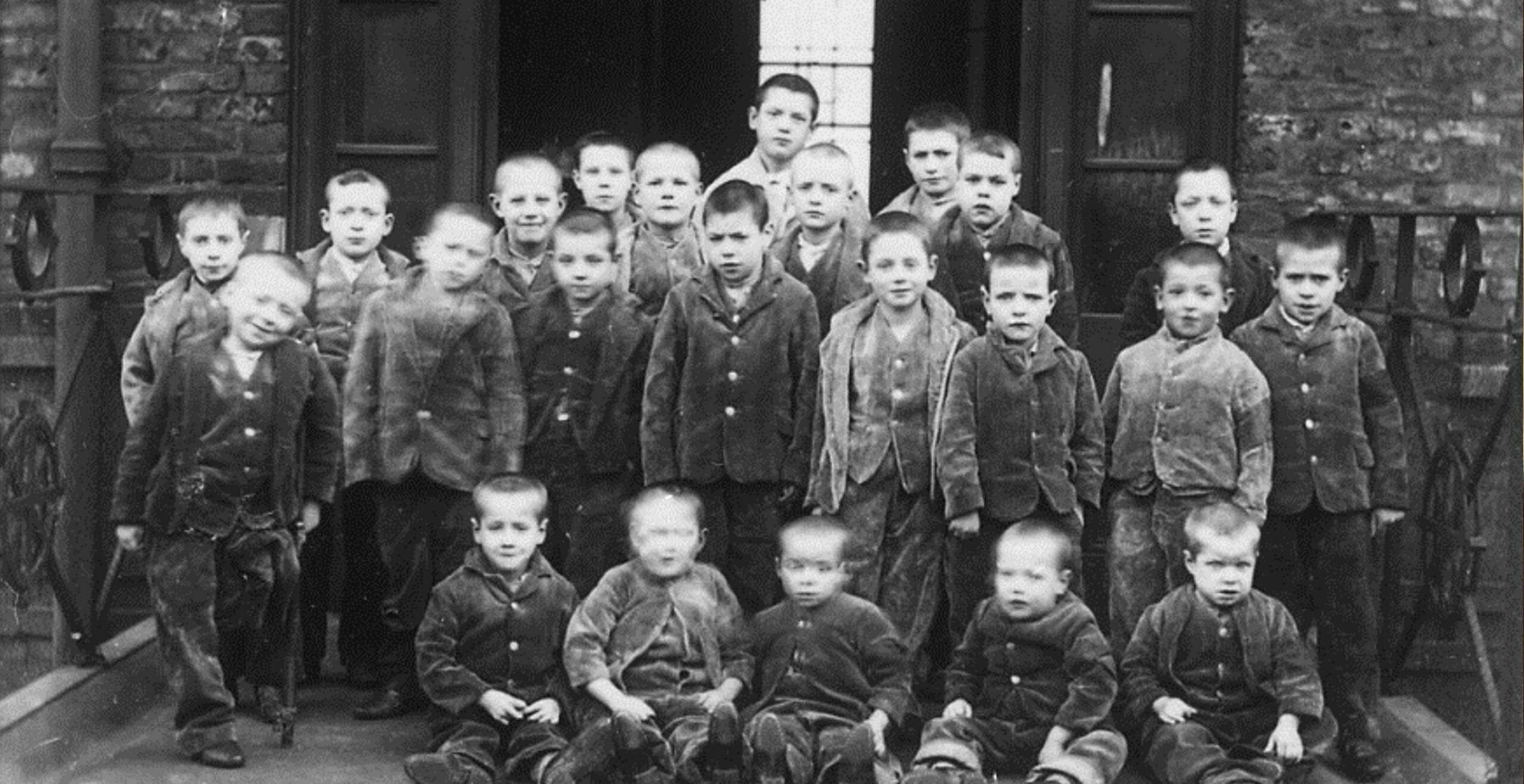Get ready to explore the fascinating world of workhouses! These places were once home to the poor and those struggling to make ends meet in Britain and Ireland. Over time, they evolved, reflecting how society viewed poverty and those in need. Let’s dive into 10 intriguing facts that will shed light on these enigmatic institutions and the lives that unfolded within their walls.
10 Facts About Workhouses: A Glimpse into a Harsher Past
Workhouses often evoke images of hardship and bleak existence, and sadly, the reality wasn’t too far off. These institutions, while aiming to address poverty, often painted a grim picture of life for those who had to call them home. Here are ten facts that offer a glimpse into this controversial chapter of social history:
- Born in 17th Century England: Imagine England in the 1600s. The idea of workhouses emerged, intended as places to house and provide work for the unemployed and destitute. The thinking was that by offering them a roof and some form of labor, they could become self-sufficient.
- Life Inside: More Struggle Than Support: The reality of workhouses often fell short of their intended purpose. These institutions became notorious for their harsh living conditions. Imagine overcrowding, insufficient food leading to malnutrition, and diseases spreading quickly due to poor sanitation – these were the stark realities faced by many residents.
- A Mix of Misfortune: Workhouses weren’t just for the able-bodied unemployed. They housed a diverse population united by misfortune: orphaned children with nowhere else to go, elderly people unable to support themselves, individuals battling illnesses, and unmarried mothers facing societal judgment and limited options.
- Work Without End: In exchange for even the most basic necessities, inmates were required to work long and arduous hours. The problem? The wages they earned were often so meager that escaping the cycle of poverty felt nearly impossible.
- Discipline and Punishment: Life inside a workhouse was governed by strict rules and a rigid system of discipline. Punishments for even minor infractions could be severe, ranging from solitary confinement, meant to isolate and break someone’s spirit, to corporal punishment like whippings.
- A System Under Scrutiny: Over time, it became increasingly clear that workhouses weren’t achieving their intended goals. Critics began to highlight the inhumane treatment endured by residents and the fact that these institutions failed to address the root causes of poverty, often perpetuating it instead.
- The 1834 Poor Law Amendment Act: This Act marked a turning point in the history of workhouses. It aimed to reform the system, but it also inadvertently made life harder for many. The Act emphasized punishment and deterrence, making workhouses even less appealing to those in need, who were often left with little choice.
- The Slow Decline: As the 19th century drew to a close, workhouses began to decline. Alternative approaches to social welfare were emerging, driven by changing societal attitudes and a growing understanding of the complexities of poverty.
- A Lingering Legacy: While workhouses are a thing of the past, their legacy continues to shape our world today. They serve as a stark reminder of the societal challenges surrounding poverty and how our responses to it have evolved. The debates surrounding welfare, personal responsibility, and social justice are all echoes of the workhouse era.
- Lessons for Today: Workhouses were born out of a desire to address poverty, but they often became symbols of hardship and social division. They remind us of the importance of understanding the complexities of poverty, of treating everyone with dignity and respect, and of the need for compassionate and effective social safety nets.
What are some facts about the workhouse?
To truly understand the reality of the workhouse system, we need to delve a little deeper. Imagine this: you’re struggling to make ends meet, and the only option left is to enter one of these dreaded institutions.
The prevailing belief at the time was that poverty was a choice, a sign of laziness. So, those in charge designed the workhouses to be intentionally harsh, hoping to scare people into working harder and staying away. However, the reality was that most people in the workhouses weren’t lazy at all. They were simply down on their luck – perhaps they lost their job, or illness had ravaged their family.
Life inside was incredibly tough. Families were cruelly torn apart upon entering – men, women, and children were strictly segregated. This separation caused unimaginable heartbreak and fear, especially for the children.
Inside those bleak walls, everyone was put to work. Hard labor was the rule, regardless of age or health. It wasn’t about teaching skills or offering a helping hand; it was about punishment, about breaking people’s spirit. The work was often pointless and backbreaking, just another way to reinforce the idea that seeking help was a shameful thing.
Overcrowding was rampant, and disease spread like wildfire. Food was minimal and often unappetizing, just enough to keep you going, but never enough to feel truly satisfied. It wasn’t uncommon for people to die within the walls of the workhouse, their lives cut short by illness, malnutrition, or sheer despair.
The psychological impact was immense. Imagine the humiliation of wearing a uniform that marked you as a pauper, the constant surveillance, the lack of privacy or control over your own life. It’s no surprise that many people emerged from the workhouse experience utterly broken, their spirits crushed.
Of course, not everyone agreed with this approach. Critics of the system – and there were many – argued that it was inhumane and counterproductive. They believed that true social reform meant addressing the root causes of poverty – such as lack of education and opportunity – rather than punishing the unfortunate souls who fell victim to it.
The legacy of the workhouse is a complicated one. It serves as a stark reminder of a time when poverty was seen as a moral failing, a time when the vulnerable were met with indifference and cruelty. While the workhouses are long gone, their story continues to remind us of the importance of compassion, empathy, and a just social safety net for all.
How many people died in workhouses?
We know life in a workhouse wasn’t a picnic. These places were designed to be a last resort, with tough conditions meant to discourage people from relying on them. But just how many people actually died within their walls?
Sadly, obtaining an exact number is difficult. Records from that time weren’t always kept perfectly, and the causes of death weren’t always clear-cut. Was it a workplace accident, an illness that spread like wildfire in cramped conditions, or just the toll of hard labor on already weakened bodies? It’s often impossible to say for sure.
What we do know is that death was a regular visitor to the workhouse. The elderly and the very young were especially vulnerable, and outbreaks of diseases like typhus and cholera could be devastating.
Some historians believe that looking at burial records in areas with workhouses might give us a clearer, though still imperfect, picture. After all, if a town’s graveyard saw a spike in burials coinciding with the workhouse being full, it paints a pretty grim picture.
It’s important to remember that the lack of a precise number doesn’t lessen the tragedy. Each death represents a life cut short, a story lost to history. While we may never know the exact number, it’s crucial to acknowledge the harsh reality of workhouse life and the impact it had on the most vulnerable in society.
What are the facts about workhouses and the Poor Law?
To understand workhouses, we need to go back to 19th century Britain. Life wasn’t easy for those struggling to make ends meet, and workhouses were seen as a last resort. These large institutions were designed to provide shelter and work, but the reality was far harsher than the initial concept.
These workhouses were a product of the Poor Law Amendment Act of 1834. This Act aimed to discourage people from relying on handouts unless they were truly desperate. To achieve this, life inside the workhouse was designed to be unpleasant, in the hopes that people would choose to find other ways to support themselves, no matter how difficult.
Life in the workhouse meant living on the bare minimum – basic food, clothing, and a place to sleep. In return, inmates had to work long and hard, often doing menial and exhausting tasks. It wasn’t a system designed to be kind; it was meant to be a deterrent.
Unfortunately, the conditions within these workhouses were often dreadful. Imagine being crammed into overcrowded spaces, with poor sanitation and disease running rampant. It’s no surprise that many people, especially the most vulnerable like children and the elderly, didn’t fare well. The death rates in workhouses were tragically high.
This system sparked outrage, and understandably so. Reformers and activists of the time were horrified by the conditions, calling them inhumane and arguing that they didn’t address the real reasons why people were poor in the first place. They believed it was merely a band-aid on a much deeper wound.
Thankfully, things began to change towards the end of the 19th century. The tireless efforts of those who fought for a fairer system, coupled with the emergence of alternative ways to help the poor, led to a decline in the workhouse system.
Here’s a simplified breakdown:
- Workhouses were a last resort for the poor in the 1800s, but life inside was incredibly tough.
- Conditions were often terrible – overcrowded, dirty, and riddled with disease.
- Many people saw the workhouse system as cruel and ineffective, leading to calls for change.
- Thankfully, by the late 1800s, people started finding better ways to address poverty, and workhouses slowly became a thing of the past.
Want to learn more?
This is just a glimpse into the world of workhouses and the Poor Law. There’s a lot more to discover about this fascinating and often heartbreaking period of history.
Did Workhouses Pay People?
We’ve discussed the harsh realities of life inside a workhouse, but did people actually get paid for all that work?
The short answer is yes, but don’t imagine it was anything close to a fair wage. Think of it more like a tiny allowance, just enough to stop you from starving.
The idea behind workhouses wasn’t really to help people escape poverty – it was more about making poverty so unpleasant that people would do anything to avoid it. The thinking was that if poor people had to endure grueling work and terrible living conditions just to scrape by, they’d be much more motivated to find better options.
And they certainly made it unpleasant. Families were often separated, with men, women, and children housed in different areas. Imagine the heartache of being separated from your loved ones, forced to live and work in a place where every day felt like a punishment.
The wages they received were a pittance, barely enough to cover the cost of basic necessities. This meant that even with a job in the workhouse, people were trapped in a cycle of poverty, unable to earn enough to improve their situation.
Naturally, not everyone agreed with this system. Critics at the time pointed out that workhouses didn’t actually address the root causes of poverty and instead punished people for being poor. They argued that the money spent on running these institutions could be better used to create real opportunities for people to lift themselves out of poverty.
Gradually, people started to listen. The workhouse system eventually began to decline as alternative forms of welfare emerged, ones that recognized the need for compassion and support rather than punishment.
The legacy of the workhouse system serves as a stark reminder of a time when poverty was seen as a moral failing rather than a social problem. It’s a reminder of the importance of understanding the complexities of poverty and the need for humane and effective solutions.
How long did workhouses last?
We’ve been talking about workhouses, those bleak places that were supposed to offer help to the poorest people in Britain. But the truth is, they were designed to be so tough and unforgiving that people would do almost anything to avoid ending up there. Now, let’s dive into how long these workhouses actually existed.
The very first workhouses appeared back in the 17th century. The thinking back then was that if life inside a workhouse was miserable enough, it would scare people into finding ways to support themselves – no matter how difficult it might be.
Sadly, these places quickly became notorious for their awful conditions. Imagine being crammed into overcrowded rooms with barely enough food to survive. People were forced to work long, hard hours, and even children weren’t spared. It’s no surprise that many people, especially the very young and old, simply didn’t survive the ordeal.
Then came the year 1834, with a new law called the Poor Law Amendment Act. This act, instead of making things better, actually made life even harder for the poor. Families were often torn apart when they entered a workhouse, and healthy adults were required to work in exchange for the most basic necessities. It was a system that seemed to punish people for being poor in the first place.
It’s no wonder that workhouses quickly became symbols of everything wrong with how society treated those in need. People began to criticize them loudly, calling out the inhumane conditions and the fact that they failed to truly help people escape poverty.
Finally, towards the end of the 19th century, people had seen enough. Workhouses were gradually phased out and eventually replaced with early forms of social welfare. These newer systems aimed to provide real assistance and support for people struggling with poverty.
Even though workhouses are long gone, they serve as a stark reminder of a time when poverty was often seen as a personal failing rather than a societal problem in need of compassionate solutions.
Why was it called a workhouse?
The name “workhouse” might seem self-explanatory – a house where people work. And while that’s true on a basic level, there’s more to uncover about why they were named this way.
The term “workhouse” itself popped up back in the 17th century. At first, it wasn’t used as broadly as it later would be. Back then, it mainly referred to places that provided housing and jobs specifically to people who were homeless and wandering around without a place to go. These individuals were often called “vagrants.”
Fast forward to the Victorian era, and the idea of a workhouse takes on a whole new meaning. This time period was marked by a belief that if you were poor, it was likely your own fault – a result of laziness or bad choices. The workhouse system became a way to deal with poverty, but not necessarily in a compassionate way. It was more about making people work for any assistance they received.
The Victorians believed that by making life in the workhouse unpleasant, people would be less likely to end up there in the first place. The name “workhouse” became synonymous with hard labor, strict rules, and frankly, a pretty miserable existence.
Some historians believe the very name “workhouse,” with all its negative connotations, might have actually contributed to the stigma surrounding poverty. It’s like the name itself reinforced the idea that being poor meant you were somehow morally flawed.
While “workhouse” was the common name, historians have found variations and more descriptive terms used over time. Some records refer to them as “houses of industry,” highlighting the emphasis on labor. Others use terms like “poorhouse” or “spike,” which give us a glimpse into the often harsh conditions and temporary nature of stays in these institutions.
Research into the history of workhouses and how they were perceived is ongoing. As historians dig deeper into historical records and uncover more personal accounts, our understanding of these institutions continues to evolve. Who knows what else we might discover about how these names shaped the way people thought about poverty and those who experienced it?
What was life really like in a workhouse?
We’ve talked about how workhouses were designed to make poverty a pretty miserable experience, but what did daily life inside these institutions actually look like?
Imagine this: long, grueling hours of back-breaking labor. We’re talking about things like picking apart old rope, breaking stones for roads, or even separating strands of wool – tasks designed to be tedious and physically demanding. And it wasn’t like a modern workplace with safety regulations; injuries were common, and treatment was basic at best.
But the tough work was only part of the story. Living conditions were rough. Imagine cramped, overcrowded dormitories, often with four people squeezed into a single bed. Sanitation? Pretty much non-existent, which led to disease spreading like wildfire. Add to that a diet that was barely enough to keep you alive, consisting mainly of watery soup and bread, and you can start to understand how grim things really were.
Children had it especially bad. Imagine being separated from your family and thrown into this system. You’d likely be sleeping in those same overcrowded dorms, wearing ragged clothes, and eating the same meager food. It’s no surprise that illness was a constant threat for these children. The emotional and psychological toll of workhouse life, especially on young minds, was probably immeasurable.
What’s truly striking is that this system, as harsh as it was, stuck around well into the 20th century. Even as people started criticizing the workhouses and coming up with new ideas for social support, families were still being sent there. This shows just how deeply ingrained this system was in society and how slow things were to change.
The legacy of the workhouses is a dark one, a stark reminder of a time when poverty was seen as a moral failing rather than a societal issue. It makes you appreciate how far we’ve come in recognizing the need for compassion and support for those struggling in tough times.
Think we know everything about the workhouses? Think again.
Historians are still uncovering details about workhouse life, and some experts believe our understanding is still evolving. For example, we might find new information about the treatment of different groups within the workhouses, like the elderly or people with disabilities. Also, research into the long-term impact of workhouses on children’s lives is ongoing. It’s a reminder that history is never truly “over.” There’s always more to learn.
What did people do in workhouses?
Life in a workhouse meant work, and not the kind that taught valuable skills or offered a path to a better life. Imagine being woken up before sunrise, crammed into a crowded room, and given a meager breakfast. Then, it was time for work – grueling, backbreaking labor.
Think breaking rocks into smaller rocks for hours on end. Or maybe you’d be “lucky” enough to get oakum picking – untangling old, tarry ropes. And all this for a tiny bit of food and a roof over your head.
The work was designed to be as unpleasant as possible, a way to discourage people from relying on the workhouse. The prevailing belief back then was that poverty was your own fault, and that making life in the workhouse miserable would somehow motivate people to do better. Of course, that’s not how things really worked, but that was the thinking at the time.
If the work was bad, the rules were even worse. Workhouses were run like prisons, with strict discipline and harsh punishments for even the smallest infractions. Talking back to the overseer could get you a beating, and stealing an extra crust of bread might land you in solitary confinement. It was a truly oppressive system.
Adding to the misery, these places were breeding grounds for disease. Imagine hundreds of people crammed together with little sanitation or ventilation – it’s no surprise that illnesses spread like wildfire. Many people suffered from things like typhus, cholera, and malnutrition.
Perhaps the most heartbreaking aspect of life in the workhouse was the emotional toll it took on people. Imagine being separated from your family, stripped of your dignity, and treated like a criminal just because you were poor. It’s no wonder that many people in workhouses experienced severe depression, anxiety, and even suicidal thoughts.
So, while we can list the tasks people were forced to do in workhouses, it’s important to remember that it was about so much more than just the work. It was about control, punishment, and a deep misunderstanding of poverty. The workhouse system was a dark chapter in history, and its legacy continues to shape our understanding of social welfare and the treatment of the less fortunate.
What are three of the jobs in a workhouse?
Life inside a workhouse meant everyone had to contribute. No work, no food or shelter. Let’s look at three common jobs within these institutions:
- Cleaning: Keeping a workhouse clean was a constant battle. Imagine scrubbing floors all day, dealing with chamber pots, and washing piles of clothes.
- Cooking: Feeding a workhouse full of people was no small feat. Someone had to spend their days peeling potatoes, stirring giant pots of soup, and baking bread. It wasn’t fancy food, but it was sustenance.
- Laundry: With everyone wearing rough clothes that got dirty quickly, washing and ironing was a never-ending chore. This wasn’t just a job for women either; men and sometimes even children had to help out.
These weren’t the only jobs in a workhouse, of course. People might also find themselves gardening, tending to farm animals, or even sewing. The point is, these jobs were rarely easy. They were often hard labor, done over and over, and if someone didn’t work hard enough, they might even get punished. It’s crucial to remember that workhouses weren’t pleasant places. They were a last resort, and the work people did was a big part of how they earned their keep.
What Happened to Children Born in a Workhouse?
Now, imagine a child born not into a loving home, but into a workhouse. These places, while intended to help the poor, were often harsh and unforgiving, especially for children. Let’s explore what life was like for these kids.
One of the saddest aspects of workhouse life was the separation of families. It was believed that separating children from their parents was the best way to teach them the importance of hard work and discipline. But in reality, it meant children faced the difficulties of workhouse life alone, without the comfort and support of their families.
And work they did. From a very young age, children were expected to contribute. Boys might find themselves sweeping floors, scrubbing dishes, or even working in coal mines. Girls were often put to work sewing, washing clothes, or helping in the kitchen. These weren’t easy jobs, and children often worked long hours in difficult conditions.
Tragically, many children didn’t survive to adulthood. Workhouses were often overcrowded and riddled with diseases like typhus and cholera. These illnesses spread quickly in such cramped and unsanitary conditions, and a child’s weak immune system was often no match for them.
Even for those who did survive, the experience left its mark. Imagine growing up without proper nutrition, constantly surrounded by sickness, and subjected to harsh treatment. It’s easy to see how this could leave children with emotional and psychological scars that might stay with them their whole lives. Some historians suggest that these experiences could have had lasting impacts on their mental and physical health and might have even affected their own children later in life.
It’s important to remember that we’re still learning about the full impact of workhouses on children. Researchers are constantly uncovering new information that helps paint a clearer picture of what life was really like inside these institutions.
Here are some key things to keep in mind:
- Abuse and Exploitation: Sadly, abuse was not uncommon in workhouses. Children were sometimes mistreated by staff or older residents, and the long hours and difficult tasks they faced could be considered a form of exploitation.
- Apprenticeships: While the idea of learning a trade might sound good, apprenticeships offered through workhouses often placed children in situations where they were treated little better than slaves, working without pay and with little control over their lives.
- Generational Cycles: The hardships faced by children in workhouses didn’t just disappear when they grew up. The poverty, lack of education, and trauma they experienced often trapped them and their own children in a cycle of hardship that was difficult to break free from.
The story of workhouse children is a complex and often heartbreaking one. By learning about their experiences, we can better understand the lasting impact of poverty and social policies on vulnerable populations, both in the past and in the present day.
Interested in learning more about other fascinating historical figures and places?
- Discover intriguing facts about King Athelstan, a pivotal figure in English history, by visiting the page about the 10 facts about King Athelstan.
- Delve into the captivating history of Mission San Diego de Alcalá with these 10 interesting facts about Mission San Diego de Alcalá, a must-read for history buffs.
- Uncover the mysteries and historical significance of the Hanging Gardens of Babylon with these 10 interesting facts about the Hanging Gardens of Babylon, one of the wonders of the ancient world.
- Unveiling the Enigma: Mansoureh Khojasteh Bagherzadeh’s Public Appearances & Private Life in Iran - July 18, 2025
- Unveiling the Mystery: Mansoureh Khojasteh Bagherzadeh’s Husband: A Rare Glimpse into a Private Life - July 18, 2025
- Unveiling Masoud Khamenei’s Mother: Power, Influence, and Iran’s Future - July 18, 2025
















